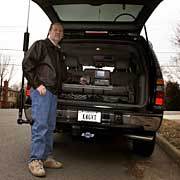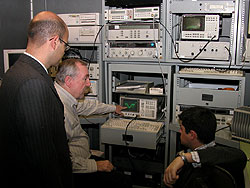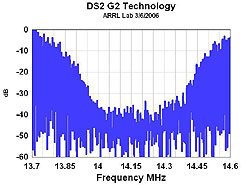| Net over power lines irks amateur radio lovers
By Peter Svensson, The Associated Press Posted 03/19/2006 07:17 PM Updated 03/19/2006 09:51 PM | |
|---|---|
George Tarnovsky can hear the Internet as he drives down Main Street in Manassas, Va., a rapid rattle emanating from the ham radio in his Chevy Tahoe.
"Suddenly you hear this incredible signal," Tarnovsky said. The radio interference, which can resemble rapid clicks or the whine of a phone-line modem, comes from a system that provides high-speed Internet access to about 1,000 Manassas customers through their power lines. The interference makes ham radio all but impossible in the Washington, D.C., suburb, Tarnovsky said. But in this fight of old and new, it appears that the old — ham radio has been around for a century — will be left standing. Broadband over power line, or BPL, is in danger of becoming an also-ran in the race to bring broadband Internet to the American home, even as it's overcoming some technical hurdles. BPL is an attractive idea because of the power grid's ubiquity. It has been touted as a "third wire" into the home, a possible competitor to broadband via cable and telephone wires — and a way to bring high-speed service to rural areas underserved by cable and phone companies. However, most of the utilities that have tried it have backed away, largely because of skepticism about the economic viability of the technology in the face of competition. BPL hasn't lived up to its early promise as a rural broadband alternative, either, because of a technical quirk that is also the source of the ham radio frustrations. For broadband, a radio-frequency signal is applied to the power line, much like a high-frequency signal is applied to phone lines to create a digital subscriber line, or DSL. But unlike phone and cable wires, power lines that run above ground can act as large radio antennas, emitting the high-frequency signal as radio waves. According to the American Radio Relay League (ARRL), the national ham radio association, radio waves from an improperly designed system can drown out amateur radio within a quarter of a mile. The antenna nature of the line also means the signal loses its energy quickly, while the line picks up radio noise from the surroundings. A long line running in a rural area needs amplifiers at short intervals, adding to the costs; even so, the signal gets lost after a few miles. The operator of the Manassas broadband system, Communication Technologies, or ComTek, said it has made adjustments to minimize interference. Tarnovsky lives five miles outside the town, but to him, that's no excuse for interfering with ham radio bands. He said the Internet signal threatens the communications services that ham radio operators can provide from their cars in emergencies such as Hurricane Katrina. "If we see interference, regardless of where it is, we have to report it to the FCC," he said. The Federal Communications Commission has generally spoken warmly about BPL's potential, but this month, after two years of complaints from ham radio operators, the FCC told Manassas to eliminate any harmful interference. Nonetheless, some companies are pushing forward, and some variants of the technology now get the thumbs-up from the national ham radio group. The ARRL is optimistic about trials conducted with Motorola's BPL technology, which uses only the short line from the nearest transformer to the home, using wireless links in place of the interference-causing long lines. It also has no problem with the USA's other major commercial BPL deployment, in Cincinnati, which uses a different technology. There, local utility Cinergy formed a joint venture with Current Communications of Germantown, Md., to sell broadband for $30 a month. It's available to about 50,000 homes, but officials won't say how many have signed up. Current is starting this year on a much larger deployment with utility TXU, covering 2 million homes in Texas, mainly in the Dallas area. It will use the next generation of its technology, allowing speeds up to 10 megabits per second, 10 times as fast as Cincinnati's and faster than most cable and DSL broadband links. For the hams, though, it's still too early to heave a sigh of relief. They say BPL systems that interfere with their bands are still allowed under FCC rules. They want tougher regulations now that non-interfering technologies such as Current's and Motorola's are available. Find this article at: http://www.USAToday.com/tech/news/2006-03-19-powerline_x.htm?csp=27 http://www.ktvu.com/technology/8139393/detail.html KTVU.com Broadband 'Net Idea Interferes With Ham Radio POSTED: 7:35 am PST March 20, 2006 A new technology and one that have been around for a long time are clashing. It centers on the use of electric transmission lines. For years, the idea of delivering broadband Internet signals over electric power lines has been touted as a way of getting high-speed links to the World Wide Web into just about every home. But ham radio operators have complained that the lines transmitting broadband data create so much interference that it affects their signals. It appears to be one of those cases where the newer technology may have to yield to the old-school method. Even though transmission of broadband data over electric wires has overcome many of its early obstacles, few companies are getting on-board because other ways of getting high-speed online links are gaining ground. Copyright 2006 by The Associated Press. All rights reserved. This material may not be published, broadcast, rewritten or redistributed.
http://www.ARRL.org/news/stories/2006/03/22/1/ League Views BPL Manufacturer's Interference Abatement Efforts with InterestNEWINGTON, CT, Mar 22, 2006--A demonstration at ARRL Headquarters of DS2 BPL equipment suggests the manufacturer is working to minimize--if not altogether eliminate--interference from its products on amateur bands, ARRL Laboratory Manager Ed Hare, W1RFI, says. Hare met with two DS2 officials earlier this month to discuss the company's improved approach to Amateur Radio band notching techniques. Based upon his observations during a demonstration of DS2's latest generation G2 technology, Hare says he's cautiously optimistic. A spectrum analyzer check of the modem's output showed the G2 modem could attain a notch depth of up to 40 dB.
"While there's no certainty that all BPL products using this technology could achieve 40 dB of protection within notched spectrum, our tests show the capability to do so is there," Hare commented. "This may not prevent all interference problems, but a 10 to 15 dB improvement over the notching used by many BPL systems in place today would be a significant improvement." In its October 2005 Petition for Further Rule Making in the BPL proceeding, ARRL cited BPL systems using Main.net and DS2 chipsets as among those that lack fixed, permanent notches in the ham bands and "have caused numerous cases of harmful interference to stations in the Amateur Service." Texas Demonstration Inspires Invitation Hare says he was intrigued by a demonstration of DS2's latest technology he witnessed last September during a United Power Line Council (UPLC) event in Texas. During his presentation, DS2 Director of Strategy and Standardization Victor Dominguez said that the manufacturer had improved the depth of the notches in its chipset. Two days later, Hare had an opportunity to see a DS2 system in Houston. Some quick tests showed that although close-in notching wasn't much better than other systems', BPL noise dropped below the ambient noise level deep into the notches. Hare and Dominguez subsequently agreed to have DS2 staff work with ARRL to investigate the company's notching improvements.
On March 9 DS2 Vice President of Technology and Strategic Partnerships Chano Gómez and Product Manager Eduardo Lluna, EA5ETP, brought a pair of modems using DS2's latest-generation G2 technology to ARRL Headquarters. Gómez directs DS2's US office in California. Lluna is based in Valencia, Spain. After a tour of Headquarters, the trio got down to work in the ARRL Laboratory's screen room, where the G2 modems were set up. The spectrum analyzer results in Figure 1 for the 20-meter band were typical of all bands measured, Hare said. "It is good to see testing that shows this implementation of technology has improved," Hare remarked. He said Gómez has offered to release application notes or other information outlining how DS2 has been able to configure its modems to achieve a 40 dB notch depth across entire amateur bands. The DS2 modems also were tested at Maxim Memorial Station W1AW, where they were plugged into outlets in separate parts of the building and set to transmit data. Hare listened on a number of ham bands and on adjacent spectrum. Inside the ham bands, the signal was inaudible, he said. "Although this was encouraging as a reasonable quick-look test of DS2 modems on premise," Hare cautioned, "testing on a BPL installation using overhead power lines would present a more realistic situation from which to draw firm conclusions." Gómez offered to look into ways such tests might be arranged. Gómez said he's happy to be working with ARRL to demonstrate that DS2's chipsets are Amateur Radio-friendly. "We have made a huge effort to ensure that the 40 dB programmable notches in our OFDM chipset provide adequate protection," he said. According to Lluna, several vendors already have deployed DS2-based equipment in the US, "and this gives them the mechanism to avoid interference problems completely." Feedback from the ARRL "has been invaluable" in achieving that goal, he added. Exchange of IdeasAfterwards, Hare, Gómez and Lluna discussed BPL and electromagnetic compatibility (EMC) issues and potential solutions to head off most cases of interference. "We had a solid exchange of ideas about the technical aspects of interference problems and how improved notch depth could be combined with other techniques to prevent and correct interference," Hare said. "The DS2 staff has a good grasp of the technical issues involved and believes many of them ultimately can be implemented in deployed systems." ARRL CEO David Sumner, K1ZZ, concurred with Hare's cautious optimism. "We very much appreciate this dialogue with DS2, and we are looking forward to turning talk into action and solutions," he said. Page last modified: 11:55 AM, 22 Mar 2006 ET Page author: awextra@arrl.org Copyright © 2006, American Radio Relay League, Inc. All Rights Reserved.
|


